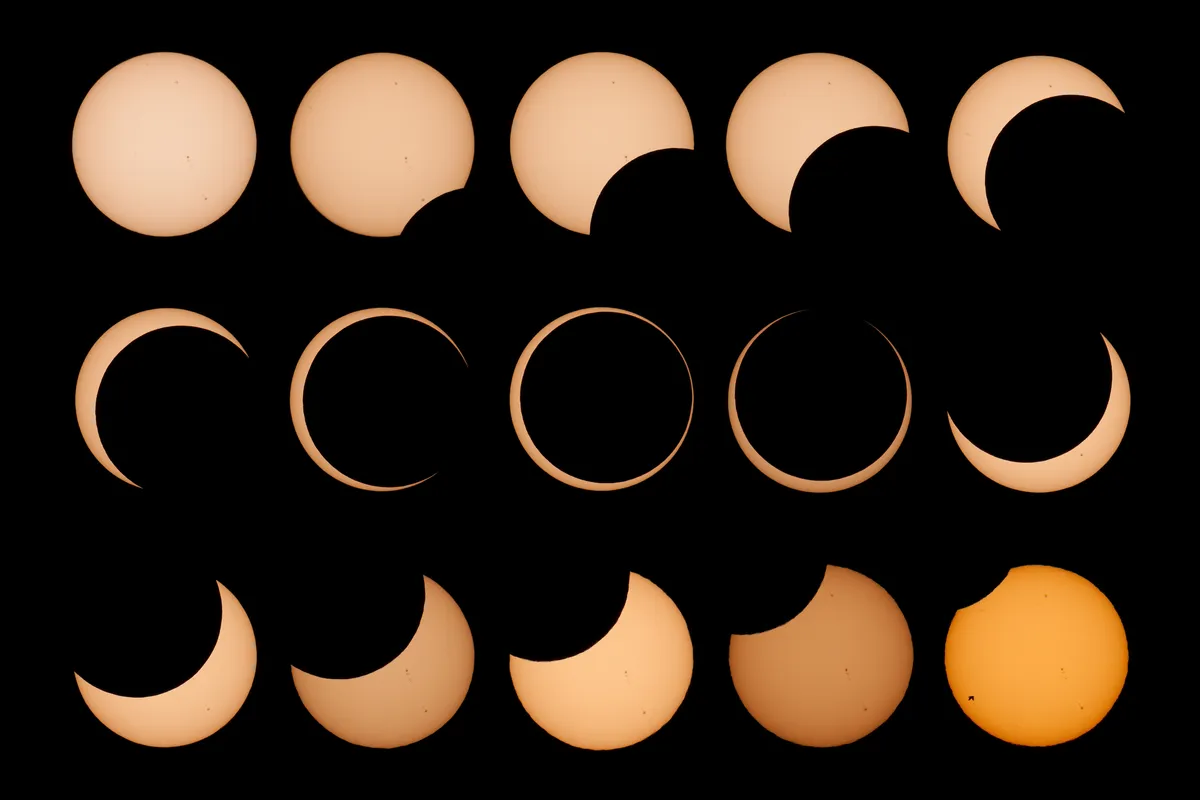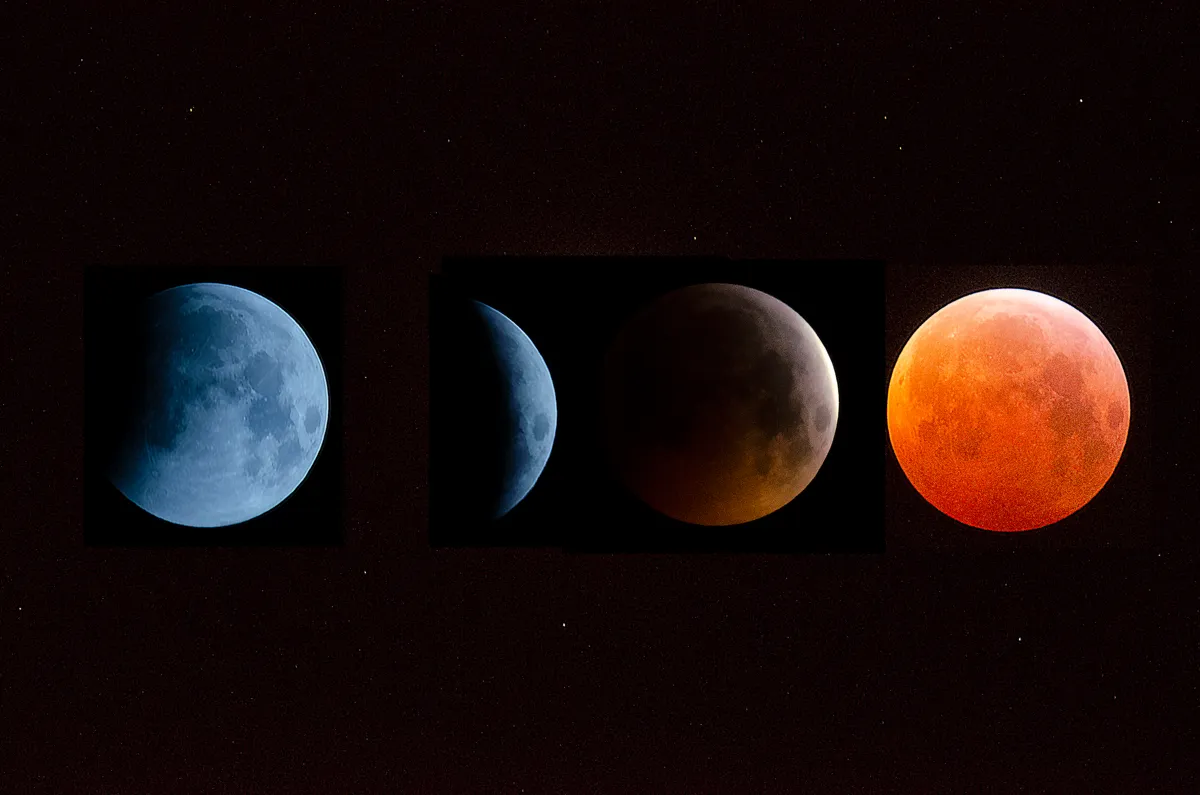Parts of the world this week will see the rarest type of eclipse; a hybrid eclipse.
But what is a hybrid eclipse? How is it different from a partial or full solar eclipse? And, where and when can you see this astronomical phenomenon?
For those who missed it, you can check out our fantastic gallery of the best pictures from the Spring Equinox 2023. If you’re looking forward to clear nights this year, why not plan ahead with our full Moon UK calendar and astronomy for beginners guide?
What is a hybrid solar eclipse?
A hybrid solar eclipse is a rare type of solar eclipse that transitions between an annular eclipse and a total eclipse. This happens as the Moons shadow moves across the surface of the Earth, essentially changing the appearance of the eclipse, depending on the observer’s location along its path.
It occurs when the Moon is too far from the Earth to completely cover the Sun, resulting in an annular eclipse at certain points along the path. However, at other points along the same path, the Moon appears larger and closer, and it fully covers the Sun, resulting in a total eclipse.
“If you are slightly closer to the Moon, the Moon appears large enough in the sky to completely hide the Sun, and we get a total solar eclipse,” explains Dr Darren Baskill, astronomy lecturer at the University of Sussex.
“But if you are slightly further away from the Moon, it appears smaller in the sky, and so doesn’t appear big enough to completely hide the Sun, and we get an annular solar eclipse instead, where the outer edge of the Sun is visible as a ring around the Moon,” Baskill says.
Why is this eclipse so special?
The path of a hybrid solar eclipse is typically narrow, and the exact type of eclipse visible from a particular location along the path will depend on the observer's position relative to the Moon's shadow.
“What is rare about Thursday’s eclipse is that it occurs when the distance between the Earth and Moon is on the borderline between these two types of eclipses, and so which you will see depends on where you are,” says Baskill.
Due to the curvature of the Earth, certain portions of the eclipse path fall within the Moon's umbra, which is the darkest part of its shadow responsible for creating total solar eclipses. Meanwhile, other regions remain beyond the reach of the umbra, resulting in an annular eclipse.
“Since the Earth is curved, some places on Earth are closer to the Moon than others, and this difference will cause some observers to see an annular eclipse while others see a total solar eclipse,” Baskill says.
Hybrid solar eclipses are extremely rare occurrences, and of the 224 solar eclipses in the 21st Century, only seven of them will be hybrid; that equates to just 3.1 per cent.
And there’s also an annular eclipse?
Yes. An annular eclipse occurs when the Moon is at a certain distance from the Earth, causing it to appear smaller than the Sun. During the eclipse, therefore, the Moon is not able to completely cover the Sun's disc, leaving a ring of sunlight visible around the Moon's edge. This ring of sunlight is known as an annulus, giving the eclipse its name, an annular eclipse.

The Moon travels around the Earth in a slightly elliptical orbit, and so the Moon's distance from Earth changes throughout its orbit. When the Moon is farthest from Earth (at its apogee) and crosses the Sun's disk during a new moon phase, it appears smaller than the Sun and an annular solar eclipse occurs.
When can I see the eclipse?
The solar eclipse is happening on20 April 2023from02:34am(UK time).
However, for us here in the UK, and across the pond in America – we won’t be able to see the eclipse. If you’re in western Australia, or Eastern Indonesia however, it’s a different story.
The hybrid solar eclipse in April 2023 will be visible from a handful of places in the southern hemisphere. The path of the eclipse begins over the Pacific Ocean before ending over the Atlantic Ocean. The transition from annular to total, and back again, will occur at remote locations at sea, so don’t expect to see this transition from land.

“During mid-eclipse on Thursday, people in East Timor are about 370,000km away from the Moon. But due to the curvature of the Earth, anyone sailing in the Pacific Ocean will be about 1 per cent further away from the Moon. And that difference is enough to make the Moon appear slightly smaller in the sky,” says Baskill.
“So, while people in East Timor will see a total solar eclipse, observers in the Pacific Ocean will witness an annular solar eclipse instead.”
“People in different places along the path of totality (where the Moon and Sun perfectly line up) will see a different type of solar eclipse on Thursday.”
“Those slightly further away from the Moon during the eclipse (such as the Pacific Ocean) will see an annular eclipse with a ring of sunlight around the Moon, whereas those countries lying a bit closer to the Moon during the eclipse will see the Moon high in the sky and will witness a total solar eclipse instead,” Baskill explains.
The North West Cape peninsula and Barrow Island in Western Australia, eastern parts of East Timor, and Damar Island, along with certain parts of the Papua province in Indonesia, will be able to witness the totality of this eclipse.
20 April 2023: When the eclipse is happening
- First location to see the partial eclipse begin: 1:34am UTC
- First location to see the full eclipse begin: 2:37am
- Maximum eclipse: 4:16am
- Last location to see the full eclipse end: 5:56am
- Last location to see the partial eclipse end: 6:59am
* UTC is one hour behind BST
When is the next eclipse?
But it’s good news for the rest of the world – solar eclipses always occur around 15 days before, or after, a lunar eclipse. And the next lunar eclipse? A penumbral lunar eclipse the afternoon before the coronation, 5 May 2023. Sadly, this won’t be visible from the UK, but it will be visible for most of Europe, Africa, Asia and Australia.
There are a total of seven hybrid solar eclipses in the 21st Century, with only four more after this year:
- 8 April, 2005
- 3 November 2013
- 20 April, 2023
- 14 November, 2031
- 25 November, 2049
- 20 May, 2050
- 6 December, 2067
However, for a partial solar eclipse, we don’t have long to wait here in the UK. The next partial solar eclipse is just under a year away, on 8 April 2024, and may be visible just before sunset, conditions permitting.
Why does a lunar eclipse always occur around two weeks before or after a solar eclipse?
A solar eclipse can occur only when the Moon passes between the Sun and the Earth, which means that it must be a new Moon. Similarly, a lunar eclipse can occur only when the Moon is in the opposite direction to the Sun from the Earth. This means that a lunar eclipse can only happen when there is a full Moon.
The lunar month, which is the time it takes for the Moon to complete one orbit around the Earth, is about 29.5 days long. This means that there is a full Moon about every 29.5 days.

If the Moon happens to be in the correct position to cause a solar eclipse during a new Moon, then it is also likely to be in the correct position to cause a lunar eclipse about two weeks before or after that event, during a full Moon. This is because the Moon's position relative to the Sun and Earth changes slowly over time, so the alignment that causes a solar eclipse can also lead to a lunar eclipse, during the same lunar cycle.
What causes a full solar eclipse?
A solar eclipse occurs when the Moon passes between the Sun and the Earth, blocking light from the Sun from reaching the Earth's surface. The alignment of the Sun, Moon, and Earth must be nearly perfect for a full solar eclipse to occur.
The Moon's orbit around the Earth is slightly elliptical (it’s not perfectly circular), and it takes about 29.5 days to complete one orbit. The Earth also orbits the Sun, taking about 365.25 days to complete one orbit.
During a new moon phase, when the Moon is between the Sun and the Earth, if the Moon passes directly in front of the Sun, it will block the Sun's light from reaching certain areas on Earth, resulting in a solar eclipse.
Do solar eclipses only happen on a new Moon?
Yes, a solar eclipse can only happen during a new Moon phase.
During the new Moon phase, the Moon is located between the Sun and the Earth, so from our point of view, the Moon is not illuminated by the Sun. While in this straight-line configuration, the Moon can pass in front of the Sun, and we get a solar eclipse.
However, not every new Moon will result in a solar eclipse, so we don’t get them every month. This is because the Moon orbits the Earth on a plane that differs from Earth’s orbit around the Sun, by around 5 degrees. This is usually enough so the new Moon can pass above or below the Sun, and the Moon’s shadow misses the Earth.
We only get them when the Moon passes through Earth’s orbital plane during a new Moon phase.
Why don’t solar eclipses last as long as lunar eclipses?
Totality during a solar eclipse may range from a few seconds to a few minutes. However, during a lunar eclipse, totality can last much longer. This was the case in May last year, with the lunar eclipse lasting just under 85 minutes.
Because a solar eclipse happens when the Moon’s shadow is cast over the Earth (i.e., the Moon blocks the Sun), solar eclipses are much shorter in duration. During a lunar eclipse, because the Earth is much larger than the Moon, the shadow cast by the Earth onto the Moon covers the Moon for longer, resulting in a longer eclipse.
The time of the eclipse is relative to the size of the body casting the shadow, and therefore the time taken to move through its umbra (the umbra is the darkest and the innermost part of the shadow cast by the Moon or the Earth during an eclipse).
About our expert, Dr Darren Baskill
Darren is an outreach officer and lecturer in the department of physics and astronomy at the University of Sussex. He previously lectured at the Royal Observatory Greenwich, where he also initiated the annual Astronomy Photographer of the Year competition.
Read more: